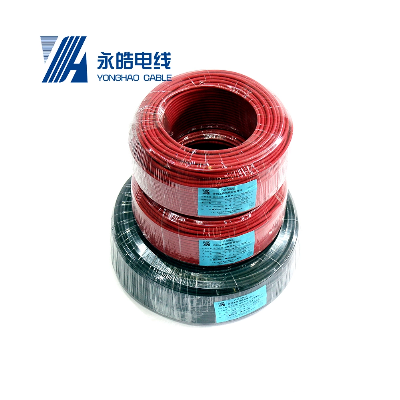Usefor Solar Plants Distribution SystemAmbient
Temperature-40ºC~+90ºCTest Voltage6500V, 50Hz, 5minAmbient
Temperature25 Years (TUV)OriginChinaProduction Capacity 1200km per
day CertificationTUVProduct NameDC Solar PV CableColorBlack ,Red
,Brown,Grey Or CustomizedSpecification1.5mm2, 2.5mm2, 4.0mm2,
6.0mm2, 10.0mm2, 16.0mm2, 25.0mm2, 35.0mm2Number of CoresSingle
Core,Two CoreTransport PackageDrum or RollRated
voltageAC:Uo/U=0.6/1.0KV DC:1.0KVVoltage test on completed
cableAC:6.5KV DC:15KV,5minWeathering /UV-resistanceHD605/A1ACID and
Alkali resistanceEN60811-2-1Cold bending testEN60811-1-4O-zone
resistance at complete cableEN50396Flame testIEC60332-1Max
Temperature at conductor+120ºCService Life25
years(-40ºC~+90ºC)ApprovalsTUV RheinlandHOT PRODUCTS63930 IEC
131Electrical solar cableTUV H1Z2Z2-K In the solar
photovoltaic power generation system in the low-voltage DC
transmission part of the cable, because the use of the environment
and technical requirements are different, the connection of
different parts have different requirements, the overall factors to
consider are: cable insulation performance, heat resistance and
flame retardant performance, aging performance and wire diameter
specifications.1. The connection cable between the solar cell
module and the module is generally connected directly by the
connection cable attached to the module junction box. When the
length is not enough, a special extension cable can also be used.
According to the different power size of the component, this kind
of connecting cable has a cross-sectional area of 2.5m square
meters, 4.4m square meters, 6.0m square meters and other three
specifications. This kind of connecting cable uses double
insulation outer skin, has superior protection against UV, water,
ozone, acid, salt erosion ability, superior all-weather ability and
wear resistance.2. Use a multi-strand flexible cable that passes
the UL test to connect the battery to the inverter. Choosing short
and thick cables can reduce system losses, improve efficiency, and
enhance reliability.3. The cables connecting the battery array to
the controller or DC junction box must also use multi-strand
flexible wires that pass the UL test. The cross-sectional area
depends on the maximum output current of the battery array.The
cross-sectional area of the DC cable at the named location shall be
determined according to the following principles: Cables connecting
solar modules, batteries and batteries, and AC load cables.
Generally, the rated current of the cables is 1.25 times of the
maximum continuous working current of each cable. For connecting
cables between the solar cell array and the square array, and
connecting cables between the battery (group) and the inverter, the
rated current of the cable selected is generally 1.5 times of the
maximum continuous working current in each cable. /* January
22, 2024 19:08:37 */!function(){function s(e,r){var
a,o={};try{e&&e.split(",").forEach(function(e,t){e&&(a=e.match(/(.*?):(.*)$/))&&1
Related products about Two Coresolar System Photovoltaic Flexible Copper PV Solar Panel Electrical Wire 2.5mm2 4mm2 6mm2 10mm2 DC Electric Solar Fiber Optic Cable
-
 Waste Tyre Plastic Recycling Machinery Machine Tire Crusher Production Line Rubber Crumb Grinding Machine Equipment Tire Shredder
Waste Tyre Plastic Recycling Machinery Machine Tire Crusher Production Line Rubber Crumb Grinding Machine Equipment Tire Shredder
-
 Stretch Plastic Blowing Pet Bottle Making Blow Molding Machine Bottles Stretch Automatic Pet Bottle Blowing Machine
Stretch Plastic Blowing Pet Bottle Making Blow Molding Machine Bottles Stretch Automatic Pet Bottle Blowing Machine
-
 Waste Plastic Pet Bottle, Water Bottle Flake, PP/HDPE/LDPE PE Film Jumbo Woven Bags Plastic Crusher Machine, Plastic Crushing Washing Recycling Machine
Waste Plastic Pet Bottle, Water Bottle Flake, PP/HDPE/LDPE PE Film Jumbo Woven Bags Plastic Crusher Machine, Plastic Crushing Washing Recycling Machine
-
 Type 2 Wall-Mounted Electric Car Charging Station 7kw /11 Kwelectric Vehicle Charging Station Home Wallbox AC EV Charger Single Phase or 3three Phase
Type 2 Wall-Mounted Electric Car Charging Station 7kw /11 Kwelectric Vehicle Charging Station Home Wallbox AC EV Charger Single Phase or 3three Phase
-
 G-View G12W Wholesale Auto Car LED Headlight Bulb High Power H13 H11 9005 H7 H4 Car LED Headlights LED Car Lights
G-View G12W Wholesale Auto Car LED Headlight Bulb High Power H13 H11 9005 H7 H4 Car LED Headlights LED Car Lights
-
 New Design Porcelain Round Plates Dinner Set for Wedding and Banquet
New Design Porcelain Round Plates Dinner Set for Wedding and Banquet
-
 China 2023 New Design Super Soft 100% Polyester Microfiber Knitted Oversized Decoration Hoodie Blanket
China 2023 New Design Super Soft 100% Polyester Microfiber Knitted Oversized Decoration Hoodie Blanket
-
 Handmade Art Creative Materials Thickened White Paper Cup DIY Disposable Handmade Colored Paper Cup
Handmade Art Creative Materials Thickened White Paper Cup DIY Disposable Handmade Colored Paper Cup



